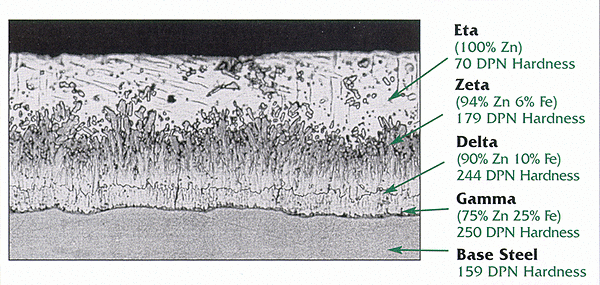Thick Coating Requests

What do I tell a customer who wants a coating much thicker than specified by ASTM A123?
Most people understand a greater zinc coating thickness will provide better corrosion protection performance to the base steel, but there are practical limitations on the coating thickness achievable. A customer may request a coating thickness over 10 mils thick [approx. 250 µm] by double dipping the steel, without being aware of some important issues. The chemistry of the steel, a brittle coating, the issues with double dipping, and the level of existing corrosion protection already present from a standard thickness, are all subjects that may be confusing to someone unfamiliar with the process. As with many topics in the hot-dip galvanizing industry, opening up the lines of communication with the customer is the best way to ensure satisfaction.
Here are some considerations when discussing requests for an excessively thick coating:
The chemistry of the steel can make it impractical
Some customers may want you to leave the steel in the zinc bath for a longer amount of time in order to produce an extra thick coating. This may be an option for reactive steels, where the thickness of the coating grows linearly with time. However, if the steel's silicon and phosphorous levels are within the recommended ranges for hot-dip galvanizing as provided within ASTM A385, the rate of the galvanized coating thickness growth will be parabolic with time, that is the growth will peak and then decline. After a short span of a quick growth rate, the thickness will grow much slower, making a much thicker coating impractical to achieve. Specifying "reactive steel" chemistry or "high-silicon" steel does not guarantee a thicker coating to the requested value will be achieved, and the use of reactive steels can sometimes result in coatings which are dull or rough in appearance/texture. In practice, stripping and regalvanizing is not a reliable or predictable method for altering the surface chemistry and should not be exercised as an attempt to meet thicker coating requests.
Excessively thick coatings may become brittle
Hot-dip galvanized coatings that are excessively thick (greater than 8-10 mils [approx. 200-250 µm]) raise concerns about the brittleness of the coating. When an excessively thick coating cools after galvanizing, the stress between the steel and the zinc can sometimes become great enough to strain the coating. Occasionally, the brittle coating may flake off or delaminate upon the application of an outside force such as rough handling of the material. Flaking is a surface conditions which often needs to be repaired for the product to perform as intended. A coating thickness closer to those recommended in ASTM A123 will not be susceptible to flaking. This may be the most important reason a thicker coating request should be evaluated thoroughly.
"Double dipping" the steel does not work
There seems to be a perception that a galvanized coating is similar to a paint coating: you can apply multiple coats to achieve a greater thickness. However, a hot-dip galvanized coating actually relies on a reaction between the steel and zinc, forming intermetallic layers that grow perpendicular to the base steel. Once the coating has cooled, redipping the material into molten zinc may only melt away the free zinc (Eta) layer of the coating and replace it with a new one upon removing it from the bath. The intermetallic layers will only grow once the steel is heated back to the galvanizing temperature. A longer initial immersion time will have the same effect as a second immersion and is a much more efficient option. The term 'double dipping' should not be confused, or used interchangeably with the term progressive dipping. Progressive dipping is done when a piece is too large to be fully submerged in the galvanizing kettle, so each end of the piece is dipped sequentially to coat the entire item.
A coating thickness near the minimum requirement typically sufficient
Often times, the corrosion protection of hot-dip galvanized steel exceeds the design life of the structure itself. Even coatings near the specified thicknesses of ASTM A123 can provide upwards of 70 years of corrosion protection with zero maintenance in atmospheric exposure. The HDG Time to First Maintenance chart and the Zinc Coating Life Predictor (ZCLP) are great tools for evaluating whether the steel will be adequately protected by hot-dip galvanizing in atmospheric exposure. Typically an excessively thick coating is not necessary. The Service Life of Galvanized Steel Articles in Soil Applications chart, along with several case studies shown on the website can also address customer concerns.
© 2025 American Galvanizers Association. The material provided herein has been developed to provide accurate and authoritative information about after-fabrication hot-dip galvanized steel. This material provides general information only and is not intended as a substitute for competent professional examination and verification as to suitability and applicability. The information provided herein is not intended as a representation or warranty on the part of the AGA. Anyone making use of this information assumes all liability arising from such use.

